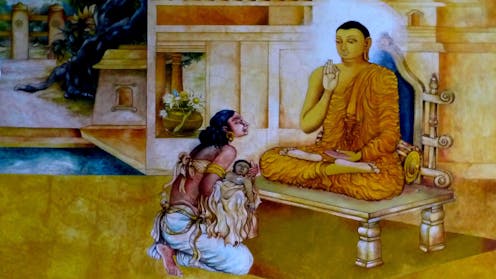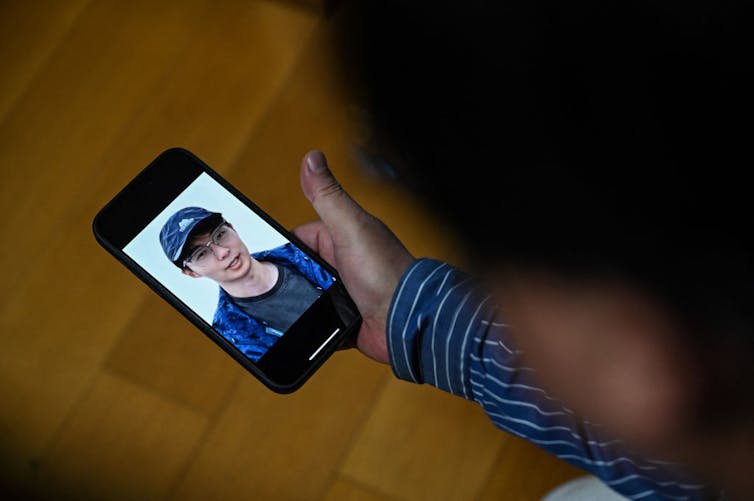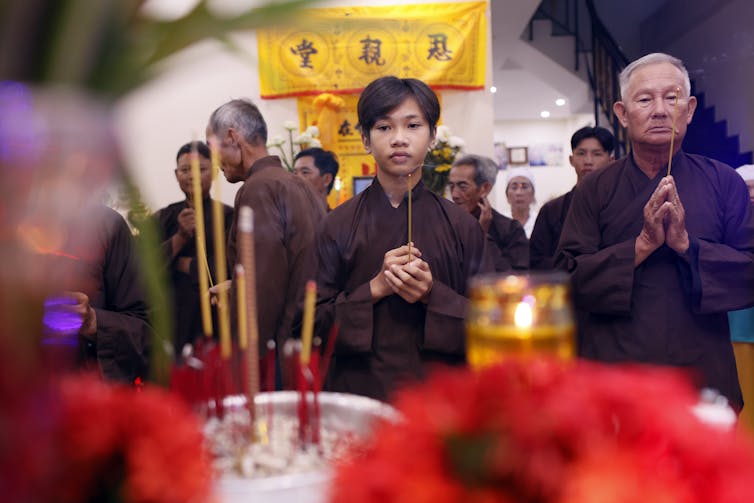It is becoming easier to create AI avatars of the deceased − here is why Buddhism would caution against it
- Written by Elaine Lai, Lecturer in Civic, Liberal, and Global Education, Stanford University
 A grief-stricken woman, Kisa Gautami, pleads with the Buddha to resurrect her dead child.Anandajoti Bhikkhu via Flickr
A grief-stricken woman, Kisa Gautami, pleads with the Buddha to resurrect her dead child.Anandajoti Bhikkhu via FlickrIn a story in the Buddhist canon, a grief-stricken mother named Kisa Gautami loses her only child and carries the body around town, searching for some way to resurrect the child.
When she encounters the Buddha, he asks her to collect several mustard seeds from a family that has never experienced death. Not surprisingly, Kisa Gautami is unable to find a single such family. She buries her child and decides to cultivate a spiritual life.
I thought of Kisa Gautami’s story when I first encountered the 2020 Korean documentary “Meeting You,” in which virtual reality technology is used to reunite a grieving mother, Jang Ji-sung, with her deceased 7-year-old daughter, Nayeon. While the virtual reunion was moving to witness, I wondered whether it was truly helping the mother to heal, or whether it was deepening an avoidance of grief and of the truth.
Since the documentary first aired, the business of digitally resurrecting the deceased has grown significantly. People are now using AI to create “grief bots,” which are simulations of deceased loved ones that the living can converse with. There has even been a case where an AI-rendered video of a deceased victim has appeared to deliver a court statement asking for the maximum sentence for the person who took their life.
 A video created with artificial intelligence shows the face and voice of a young man who died at 22 while attending Exeter University in Britain.Hector Retamal/AFP via Getty Images
A video created with artificial intelligence shows the face and voice of a young man who died at 22 while attending Exeter University in Britain.Hector Retamal/AFP via Getty ImagesAs a Buddhist studies scholar who has experienced several bereavements this year, I have turned to Buddhist teachings to reflect on how creating a digital afterlife for loved ones may inadvertently enhance our suffering, and what alternative ways of grieving Buddhism might offer.
Buddhism’s view on suffering
According to Buddhist thought, the root of all suffering is clinging to illusions. This clinging creates karma that perpetuates negative cycles – for oneself and others – which endure lifetimes. In Mahayana Buddhism, the path to liberate oneself from this suffering begins by becoming a bodhisattva, someone who devotes their life to the liberation of self and others. Mahayana Buddhism, which introduced the idea of celestial bodhisattvas, is the most widely practiced form of Buddhism, particularly in East Asia and the Tibetan Himalayan regions.
In the “37 Practices of All the Bodhisattvas,” the 14th-century author Gyelse Tokme Zangpo wrote:
The practice of all the bodhisattvas is to let go of grasping When encountering things one finds pleasant or attractive, Consider them to be like rainbows in the summer skies – Beautiful in appearance, yet in truth, devoid of any substance.
A digital avatar of the deceased may provide temporary comfort, but it may distort reality in an unhealthy way and intensify our attachment to an illusion. Interactions with a griefbot that responds to our every request may also diminish our memories of the deceased by creating an inauthentic version of who they were.
Grief as a catalyst for compassion
In the tradition of Buddhism that I specialize in, called the Great Perfection – a tradition of Vajrayana Buddhism, which is a branch of Mahayana – uncomfortable feelings such as grief are considered precious opportunities to cultivate spiritual insight.
In a text called Self-liberating Meditation, a 19th century mendicant teacher of the Great Perfection known as Patrul Rinpoche wrote: “No matter what kind of thoughts arise – be they good or bad, positive or negative, happy or sad – don’t indulge them or reject them, but settle, without altering, in the very mind that thinks.”
The Great Perfection contends that all of our emotions are like temporary clouds, and that our true nature is awareness, like the blue sky behind the clouds. Grief and other challenging emotions should not be altered or suppressed but allowed to transform in their own time.
In a culture where we are taught that negative emotions should be eliminated or pushed aside, not pushing away grief becomes a practice of great kindness toward oneself. By cultivating this awareness of our emotions, grief becomes a catalyst for compassion toward others. In Buddhism, compassion is the seed of awakening to the truth of interdependence – the fact that none of us exist as discreet beings but are deeply interconnected with all other beings and life forms.
Communal rituals
 Funeral ceremony in a Buddhist family in Vietnam.Godong/Universal Images Group via Getty Images
Funeral ceremony in a Buddhist family in Vietnam.Godong/Universal Images Group via Getty ImagesCompassion manifests outwardly in community rituals that process grief, such as the 49-day Buddhist service, common to the Great Perfection and other Buddhist traditions.
Many Buddhists believe that it takes 49 days for the consciousness of the deceased to transition into their next life. During this time, the family sets up a special altar and recites prayers for the deceased, often with the support of ordained monks and nuns. Practicing generosity toward others is also recommended to accumulate merit for the deceased.
These communal rituals provide much-needed outlets, time and support for processing grief and having it witnessed by others. The time and attention given to the grief process sharply contrasts to the situation in the United States, where bereavement leave is often limited to three to five days.
Deepening relationship with impermanence
In opting for digital avatars, we may undermine what Buddhism would consider to be critical moments for genuine transformation and connection.
When I think of the family and friends who have passed away this year, I empathize with the desire to hear their voices again, or to have conversations that provide closure where there was none. Rather than turning to a technological fix that promises a reunion with the deceased, I choose to deepen my relationship with impermanence and to savor the fleeting moments that I have with those I love now.
As Kisa Gautami’s story shows, the desire to bring back the dead is not new, but there is great benefit in allowing grief to run its course, including a felt sense of compassion for oneself and all others who have ever experienced similar forms of grief.
Elaine Lai does not work for, consult, own shares in or receive funding from any company or organization that would benefit from this article, and has disclosed no relevant affiliations beyond their academic appointment.
Authors: Elaine Lai, Lecturer in Civic, Liberal, and Global Education, Stanford University

